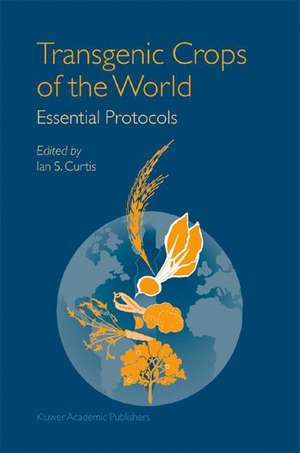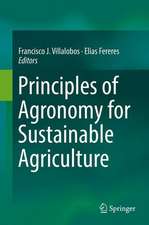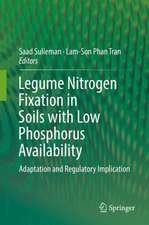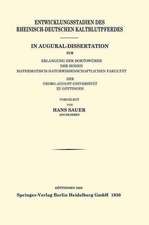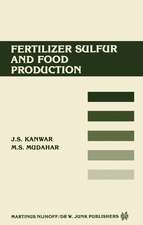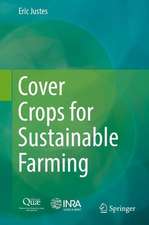Transgenic Crops of the World: Essential Protocols
Editat de Ian S. Curtisen Limba Engleză Hardback – 30 noi 2004
| Toate formatele și edițiile | Preț | Express |
|---|---|---|
| Paperback (1) | 952.57 lei 6-8 săpt. | |
| SPRINGER NETHERLANDS – 4 aug 2012 | 952.57 lei 6-8 săpt. | |
| Hardback (1) | 958.73 lei 6-8 săpt. | |
| SPRINGER NETHERLANDS – 30 noi 2004 | 958.73 lei 6-8 săpt. |
Preț: 958.73 lei
Preț vechi: 1169.19 lei
-18% Nou
Puncte Express: 1438
Preț estimativ în valută:
183.45€ • 192.05$ • 151.79£
183.45€ • 192.05$ • 151.79£
Carte tipărită la comandă
Livrare economică 05-19 aprilie
Preluare comenzi: 021 569.72.76
Specificații
ISBN-13: 9781402023323
ISBN-10: 1402023324
Pagini: 454
Ilustrații: XII, 454 p.
Dimensiuni: 155 x 235 x 25 mm
Greutate: 0.83 kg
Ediția:2004
Editura: SPRINGER NETHERLANDS
Colecția Springer
Locul publicării:Dordrecht, Netherlands
ISBN-10: 1402023324
Pagini: 454
Ilustrații: XII, 454 p.
Dimensiuni: 155 x 235 x 25 mm
Greutate: 0.83 kg
Ediția:2004
Editura: SPRINGER NETHERLANDS
Colecția Springer
Locul publicării:Dordrecht, Netherlands
Public țintă
ResearchCuprins
I: Cereals and Grasses.- Chapter-1: Transgenic rice plants.- Chapter-2: Transformation of wheat by biolistics.- Chapter-3: Genetic transformation of barley (Hordeum vulgare L.) by co-culture of immature embryos with Agrobacterium.- Chapter-4: Maize transformation.- Chapter-5: Genetic engineering of oat (Avena sativa L.) via the biolistic bombardment of shoot apical meristems.- Chapter-6: Generation of transgenic rye (Secale cercale L.) plants with single and defined T-DNA inserts, following Agrobacteriummediated gene transfer.- Chapter-7: Particle inflow gun-mediated transformation of Sorghum bicolor.- Chapter-8: Sugarcane transformation.- Chapter-9: Biolistic transformation of fescues and ryegrasses.- II: Woody Plants.- Chapter-10: Transformation of banana using microprojectile bombardment.- Chapter-11: Agrobacterium-mediated transformation of citrus.- Chapter-12: Coffa spp. genetic transformation.- Chapter-13: Genetic transformation of tea.- Chapter-14: Microprojectile-mediated transformation of pineapple.- Chapter-15: Regeneration and genetic transformation of apple (Malus spp.).- Chapter-16: Genetic transformation of pear via Agrobacterium-mediated gene transfer.- Chapter-17: Agrobacterium-mediated transformation of grape embryogenic calli.- Chapter-18: Agrobacterium-mediated genetic transformation of cotton.- III: Root Crops.- Chapter-19: Agrobacterium-mediated transformation of potato.- Chapter-20: Genetic transformation of radish (Raphanus sativus L.) by floral-dipping.- Chapter-21: Genetic transformation of Allium cepa mediated by Agrobacterium tumefaciens.- Chapter-22: Transformation of carrot.- Chapter-23: Production of transgenic cassava (Manihot esculenta Crantz).- IV: Legumes, Brassicas, fruits and oilseed crops.- Chapter-24: Soybean transformation using the Agrobacterium-mediated cotyledonary-node method.- Chapter-25: In vitro regeneration and transformation of Vicia faba.- Chapter-26: Gene technology in pea.- Chapter-27: Agrobacterium-mediated transformation of cabbage.- Chapter-28: Agrobacterium-mediated transformation of canoa.- Chapter-29: Transformation of cauliflower.- Chapter-30: Tomato transformation —the nuclear and chloroplast genomes.- Chapter-31: Genetic transformation of watermelon.- Chapter-32: Genetic transformation of sunflower (Helianthus annuus L.).- Abbreviations.
Caracteristici
Is a state-of-the-art, compilation of the most up-to-date methods available for the genetic manipulation of the major crops of our world
